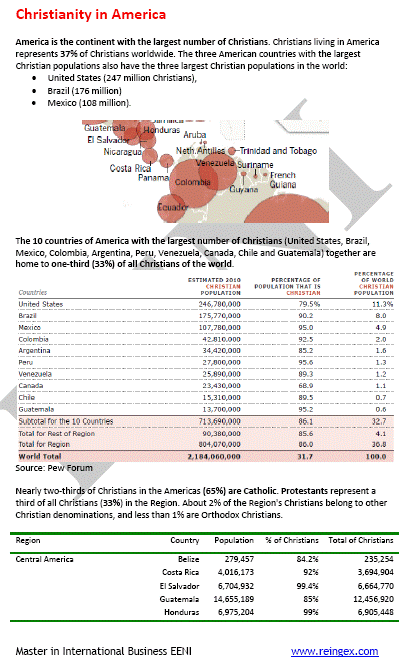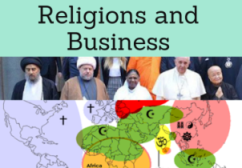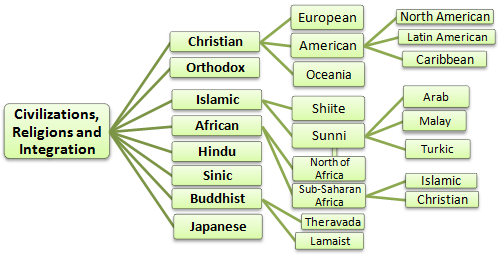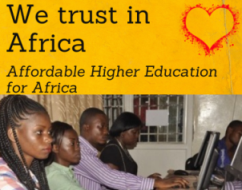American Economic Area, Christian Civilization
Economic integration in America, the Caribbean, MERCOSUR, Andean Community
Within the American Economic Area of Western Civilization from historical, cultural, and economic integration point of view, we can identify three areas.
- Hispanic American Economic Area
- The Caribbean Economic Area
- North American Economic Area

Religious diversity and geopolitical tensions
Module “American Economic area of Western Civilization” consists of seven parts:
- Introduction to the American Economic Area
- Christianity in America
- Main Economic Organizations in America
- The three economic sub-areas in America of Western Civilization
- North American economic area
- Hispanic American Economic Area
- The Caribbean Economic Area
- The American economic integration of Western Civilization (Economic Organizations, Trade Agreements)
- Christian businesspeople of the American Economic Area of Western Civilization
- American Christian spiritual leaders


Religions and Global Business -
Religious diversity
The main objective of the module is to define the characteristics of the American Economic Area of Western Civilization and its three sub-areas:
- North American
- Latin American
- The Caribbean

Module “American Economic Area (Western Civilization)” is included within the curriculum of the following academic programs at EENI Global Business School:
Master in International Business, Religions & Business

Doctorate: Ethics, Religions & Business, Foreign Trade.
Languages:  or
or  Civilización Americana
Civilización Americana  Civilizacion Americaine
Civilizacion Americaine  Civilização Americana.
Civilização Americana.
1- Introduction to the American Economic Area of Western Civilization
- The American continent
2- Christianity in America.
Christianity in America.
- Catholicism in America
- Protestantism in America:
- Judaism and Agnosticism in America
3- Main economic institutions in America.
- Organization of American States (OAS)
- Inter-American Development Bank (BID)
- Economic Commission for Latin America (ECLAC)
4- The three Economic areas of Western Civilization in America.
5- Christian Businessman.
- Carlos Slim
- Luis Sarmiento
- Antonio of Moraes
- João Marinho
- S. Truett Cathy
- Philip Anschutz
- Ray Hunt
- Howard Ahmanson
- Steve Strang
- Thomas Monaghan
- Giving Pledge
- Bill Gates (*)
- Warren Buffett (*)
(*) Agnostics but belonging to this civilization.
6- American Spiritual leaders.
American Economic Area of Western Civilization.
- North American Economic Area: The United States and Canada. The United States is the world's political leader and the first Global Economy. The EU and the United States account for 50% of the total global GDP. Canada is one of the strongest economies
- Hispanic American Economic Area. The Hispanic America Countries seek to integrate their economies: MERCOSUR, ALADI, UNASUR, ALBA, Pacific Alliance.
- The Caribbean Economic Area. The Caribbean comprises Antigua and Barbuda, the Bahamas, Barbados, Dominica, Grenada, Haiti, Jamaica, Montserrat, Saint Kitts and Nevis, Saint Lucia, Saint Vincent and the Grenadines, and Trinidad and Tobago. Total population: 15 million people. The main integration process is CARICOM

Today Christianity is the main religion of the American continent, but in the pre-Columbian Era, there were several Native American religions, many of which have survived. The presence of these religions is evident in countries like Guatemala, Bolivia, Mexico, Peru, Ecuador, and Brazil. Approximately, the Native American population is 50 million people.
Finally, it should be noted the influence on many American Countries of the African Diaspora (200 million of Afro-American descendants of the 30 million Africans were stolen from Africa and transported as slaves to America). The Afro-Americans belongs to the Christian Civilization (America) but may also belongs to African Civilization (included in the African Union vision of a United Africa).

(c) EENI Global Business School (1995-2025)
Top of this page











 WhatsApp
WhatsApp